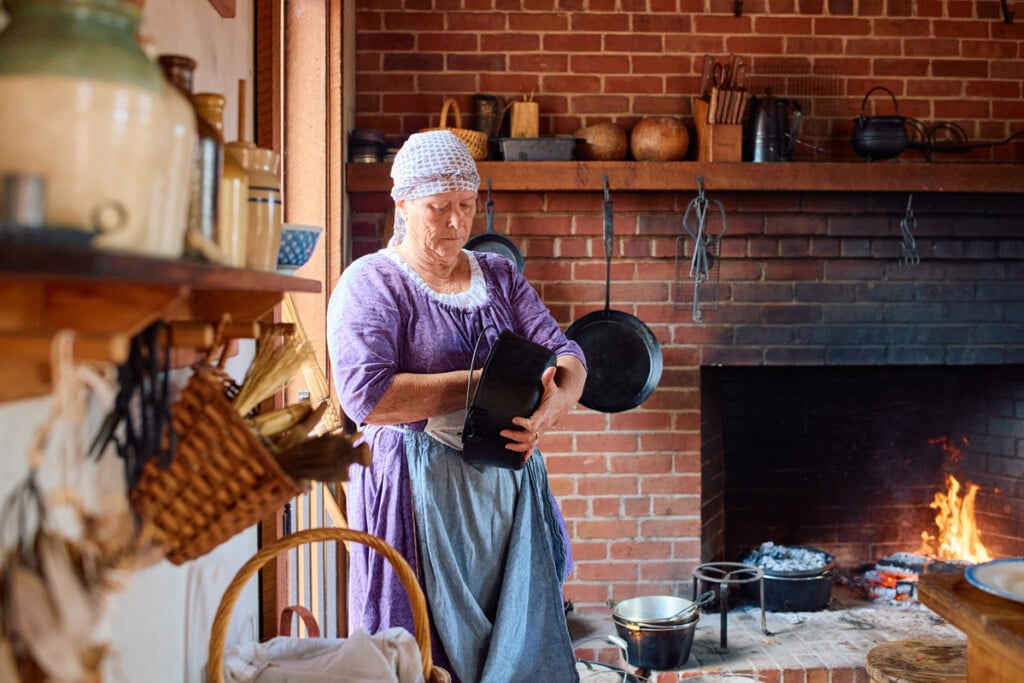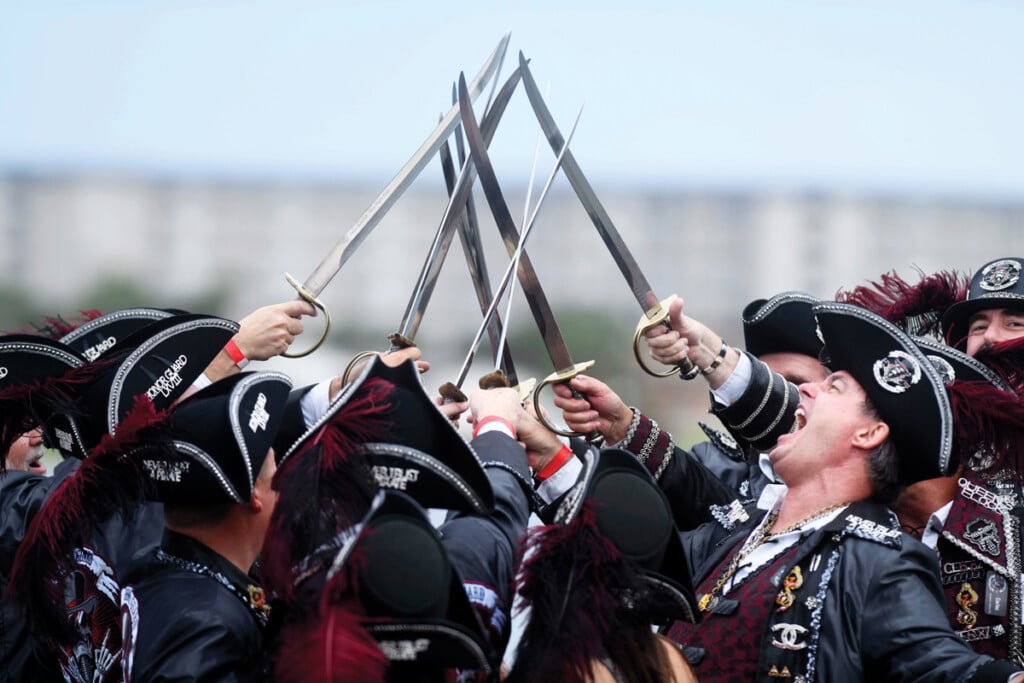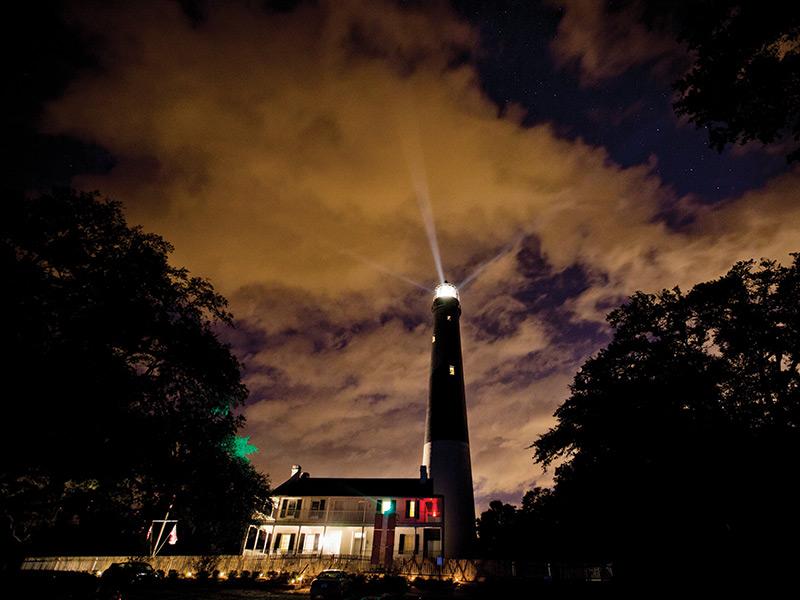Living History
The City of Five Flags comes to life at Historic Pensacola Village

Pamela Holt strolled out of the small outdoor kitchen house on Zaragoza Street at the Historic Pensacola Village with a look of mild consternation on her face.
“My pumpkin pie turned out to be a pumpkin custard,” she announces with a wry grin, her voluminous 19th-century skirts and aprons rustling as she moves about the smoky courtyard.
Holt, who volunteers as a living history interpreter at Historic Pensacola, has learned that not every recipe goes to plan when you’re baking over an open flame.
“I demonstrate talents from 1805,” she says. “My big challenge is keeping the fires going!”
Back inside the tidy, rustic kitchen—a replica constructed in 2013—another volunteer, Donna Waters, is bent over two large cast iron pots, one filled with red beans and rice.
“I’m just trying to get my broth to boil, so I can cook the rice and let my red beans stew until they’re nice and thick,” Waters says. “I’ll have a good dinner in a little while.”
Waters, who retired during the pandemic and wanted to keep busy, started volunteering at Historic Pensacola about three years ago.
“I just fell in love with it, and it’s what I do now,” she says. “It’s fun, especially in the winter and spring. It’s no fun at all in August to cook over an open fire wearing three layers of clothing!”
Historic Pensacola’s living history component is a big part of what makes the experience unique, says Phillip Mayhair, education and interpretation supervisor at the village.
“We are all super passionate about it,” he says. “What we do here is bring history to life. It’s a tool in our toolbox that we can use to educate the public.”
Pensacola is known as the City of Five Flags—having been under British, Spanish, French, Confederate, and American rule—and nowhere is that more apparent than Historic Pensacola Village.
Spanning 8.5 acres, the village is bordered by Government Street to the north, Main Street to the south, Palafox Street to the west, and Florida Blanca Street to the east and reflects a rich variety of cultures dating back 450 years. The village also features a wide range of architectural styles including Mediterranean revival, Renaissance revival, Greek revival, Classical revival, French Creole and folk Victorian.
Historic Pensacola operates under the University of West Florida Historic Trust and includes 30 properties, 12 of which are open to the public.
The heart of the village is the courtyard on Zaragoza Street where visitors can learn about family life, pastimes, and children’s games typical of the early 19th century. While women primarily occupied themselves with domestic chores, men at the time would have held a variety of jobs that included military service, brick laying, dock work, carpentry, blacksmithing, and leather work.
“I do think it is kind of a hidden treasure for Pensacola,” Mayhair says. “We can learn what life was like and really appreciate what we have today.”
Living history reenactments and displays across the village are all meticulously researched—from the fabric of the volunteers’ costumes to the food cooking in the kitchen to the plants growing in the garden.
“We don’t do anything without first doing a deep dive into the history,” says Mayhair, who is currently pursuing a master’s degree in museum studies at UWF. “We’re always updating, and as we make new discoveries, we incorporate those into our tours and programs.”
The courtyard features the Lavalle House, built in 1805 during Florida’s second Spanish period and the city’s oldest standing example of a French Creole cottage, and Julee Cottage, built around 1805 and named for one of its earliest and most intriguing owners, Julee Panton, who was a free woman of color.
“We don’t know if she was ever enslaved,” Mayhair said. “What we do know is that she owned the home for a period in the early 1800s … and rented it out. She was a businesswoman, a candlemaker.”
Visitors can take self-guided tours of Julee Cottage while Lavalle House is part of the guided tour that showcases Pensacola’s evolution from the early 1800s to the early 1900s. The guided tour also includes Old Christ Church, the Dorr House, and the Lear/Rocheblave House.
Completed in 1832, Old Christ Church has served the city as an Episcopal church, a public library, and a museum. Dorr House was built in 1871 when the lumber industry was thriving and is currently furnished to reflect a Victorian-era family home. The Lear/Rocheblave House, the final stop on the tour, reflects a 1920s boarding house complete with the influences of jazz and Prohibition.
Other highlights across Historic Pensacola Village include the Museum of Commerce, Museum of Industry and Pensacola Museum of History, which was built in 1907 as Pensacola’s City Hall.
“We just want people to know we are here,” Mayhair says. “It’s just a very vibrant place. It’s a place to learn our history, to learn the lessons of the past and where we came from.”
CHECK IT OUT
Admission provides entrance to the Pensacola Museum of Art, Pensacola Museum of History, Pensacola Children’s Museum, and the museums of Historic Pensacola Village for seven days. Included with admission are guided historic house tours offered at 11 a.m., 1 p.m., and 2 p.m. Tuesday-Saturday. Learn more about Historic Pensacola Village at HistoricPensacola.org.



